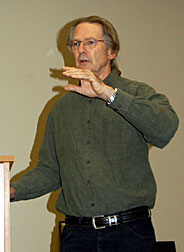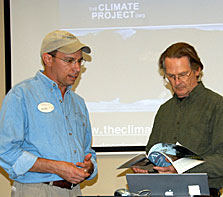
Assisting to educate one million people in the next 12 months about global warming is the role assumed locally by David Gordon, Ph.D., an associate professor of biology at Pittsburg State University, Pittsburg, KS. Gordon, pictured at right, was one of 800 chosen out of over 2000 applicants for a two-day training session in Nashville by former Vice President Al Gore and his team of scientists and educators.
Using a slide show Gordon recently presented a condensed version of Gore's An Inconvenient Truth at a gathering of community members at the Wildcat Glades Conservation and Audubon Center in Joplin. His vivid pictures illustrated a range of events that he said provides mounting evidence for global warming.
Picture after picture of glaciers--Grinnell, Portage, Columbia, Qori Kalis, Upsala--were flashed on the screen showing the size they were versus the size they'd become. If a picture replaces a thousand words then trying to describe the emotional reaction to the melting of glaciers is impossible.
Labeling the melt a "worldwide phenomenon," Gordon called attention to the fact that "40 percent of the world's population depends on the melting glaciers that are drying up."
Warming affects the size of glaciers but also ice shelves, or thick plates of ice, fed by them. 2002 was not a good year for ice shelves, Gordon demonstrated in pictures. The biggest ice shelf in the Arctic that had been in existence for at least three millennia, the Ward Hunt Ice Shelf, lying along the northern coast of Ellesmere Island in northern Canada, was shown cracked in half. And the Larsen Ice Shelf, a large floating ice mass on the eastern side of the Antarctic Peninsula was shown shattered.
These pictures were followed by a visual of Greenland, the island located between the Arctic and Atlantic oceans, showing lakes piled on top of the ice. Gordon postulated that with an increasing number of earthquakes and the pooled water, Greenland could separate and collapse like Larson.
And if those images weren't enough, Gordon illustrated how permafrost, soil at or below the freezing point of water, is declining. In an area of Alaska, Gordon showed that trucks once able to drive over frozen tundra are now immobilized.

At left, Chris Pistole, education director, Wildcat Glades Conservation and Audubon Center in Joplin, discusses the impact of global warming with Pittsburg State University biology professor David Gordon before Gordon's talk at the center. Gordon is checking out an article on global warming in the September-October 2006 issue of the Audubon magazine that Pistole had given him.
The average land, air and sea temperatures since 1980 are trending upwards worldwide, Gordon explained, as he attempted to correlate the ice ages with CO2 concentration. Statistics, he said, are showing that the 10 hottest years on record have occurred in the last 14 years, the intensity of storms has increase 50 percent and in the past couple of years a new record of severe tornadoes has been recorded. But can this be attributed to man's contribution of CO2 in the atmosphere?
Scientists are bitterly at odds over this and people that want to condemn Gore for his thinking call attention to the debate. The increase in the air’s carbon dioxide would suggest a rising global temperature, all other things being equal. However, it is difficult to calculate the response of the climate system to the small amount of energy added by the presence of extra carbon dioxide in the air. The reason for this, according to Gordon is that "global climate is a non-linear system, like compounding interest. "With ocean currents distributing heat and energy we have no idea the consequences," Gordon added. He likened scientific discovery to peeling the layers of an onion.
So, what does this all mean to the average citizen who doesn't want to give up the "luxury" of owning a gas-guzzling vehicle? Even Gore, many people point out, is not one to give up the excesses in his life. And in a choice between promoting the economy and preserving the environment, the economy has increasingly won out.
Gordon says that individuals should calculate their impact on the environment by creating a carbon footprint.
With seven percent of energy going into computer peripherals, as an example, Gordon said, just switching out exit lights to LED rather than building new nuclear plants would be a solution. He also suggested replacing household bulbs with compact fluorescent light bulbs, putting into practice efficient automobile use, and changing out appliances such as a refrigerator for one more energy efficient.
"Seven and one half tons of CO2 are put into the atmosphere by the average household," Gordon said. "If you don't believe it, Google it."
For those who missed this presentation, Gordon will present a similar one at 7:30 p.m. on Thursday, Dec. 6, 2007, Room 102, Yates Hall on the PSU campus. Sponsored by Sperry-Galligar Audubon, it is free.






Comments